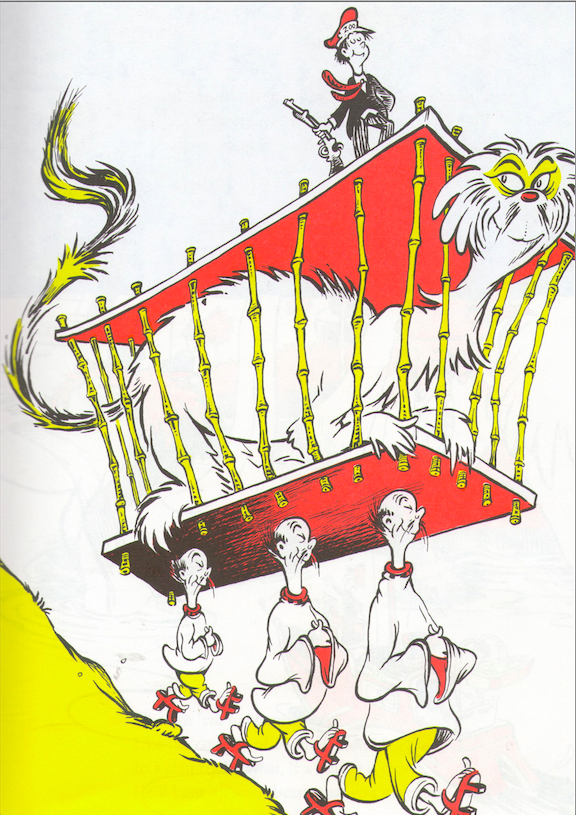Surprise! It’s Racist! Unwanted Children’s Book Surprises.
 I think many of us have done this at some point. You’ve picked up a favorite old children’s book to read to your own kiddos. Everything’s going smoothly and you’re all having a fabulous time. Then, WHAMMO! Surprise! It’s racist!
I think many of us have done this at some point. You’ve picked up a favorite old children’s book to read to your own kiddos. Everything’s going smoothly and you’re all having a fabulous time. Then, WHAMMO! Surprise! It’s racist!
Have no idea what I’m talking about? Well today we’re talking race and we’re talking classic children’s books. It’s a match made in heaven!
A couple things inspired this post and the first was when I received a copy of the new edition of If I Ran the Zoo by Dr. Seuss. Ladies and gentlemen if prior to reading this book you had asked me whether or not Dr. Seuss was ever racist in a picture book I would have laughed you off. WWII political cartoons? Sure. But his books? Not unless you count that theory about The Cat in the Hat and the elevator operator. Then I bring this book home and my husband proceeds to read it to my daughter. It’s all going well for a while . . . then we have some problems.
There are the little African guys, grass skirts and all:

There’s the Arabic fellow where it is suggested that he be collected along with his steed.

And then there’s this:

The text honest-to-goodness uses the term “slant-eyes” at one point.
You see, when it comes to surprising racism, we all sort of expect Native Americans and African-Americans to fare poorly. We tend to forget how AWFUL Asian people had it, and they show up all the friggin’ time. Whether it’s The Cricket in Times Square (see this rather lovely critique of it here) or Cheaper by the Dozen (check out the chapter “Chinese Cooking”) it’s out there. But the most unexpected racism? Voila:

Surprised? Many of us have heard the tale of how the Oompa Loompas were changed from African pygmies to something significantly less offensive in Charlie and the Chocolate Factory. So why does no one recall that Charlie and the Great Glass Elevator has its own cringe-worthy moment? I suspect because it isn’t accompanied by any art. You see, there’s a moment when the President calls the Prime Minister of China . . . I’ll just leave it at that. Let your imagination fill in the details.
Not that there aren’t surprises in books where Native American and African-Americans fare poorly. We all know the Little House books are racist but we forget the details until we stumble on them. Then there are the fuzzy cases.
I was having dinner with librarian Kyle Lukoff and we were discussing these types of books. Heck, that conversation was the real impetus for this post. We covered the usual suspects (Pippi in the South Seas, Doctor Doolittle, etc.) when Kyle pointed out a book that might not be out-and-out racist but sure is unfortunate. Remember the Mr. Men books? Of course you do. So do any of you guys remember this fellow?

Author/illustrator Richard Hargreaves was an Englishman so one can hope that the term “uppity” perhaps did not have the same connotations in his part of the globe as here. Maybe. It’s just awfully odd that the only brown-skinned Mr. Men character I can think of happened to get that particular moniker. The scan here makes him look possibly purple. It would be better.
For my part, lots of my favorites have one element that drives me crazy: cannibals. Lots of my dearly beloved books from childhood turn out to be just chock full of them. From The Thyme Garden and Magic by the Lake (both Edward Eager) to Bednob and Broomstick and The Phoenix and the Carpet, seen here:

Doggone it.
So fess up. What’s your childhood favorite that caught you off guard years later?
![]()
RELATED
The job outlook in 2030: Librarians will be in demand
The job outlook in 2030: Librarians will be in demand
ALREADY A SUBSCRIBER? LOG IN
We are currently offering this content for free. Sign up now to activate your personal profile, where you can save articles for future viewing






Add Comment :-
Comment Policy:
Comment should not be empty !!!